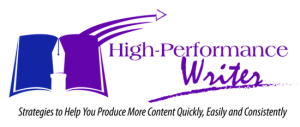Monday, April 20, 2015

Writing a book is like exercising. At some point, if you truly want to become an author—or get in shape for authorship—you have to follow Nike’s advice and “Just do it.” You have to stop finding excuses and start a book manuscript. Then you have to keep writing until you reach your goal—finish your manuscript. Then you pick a new goal; you write another book. It’s that simple That’s how you exercise your writing muscles and become an author.
For the last five years or so I’ve argued that I had no time for exercise. I would sporadically go for a walk or a bike ride, but I allowed myself to sit at my desk for hours every day and to become flabby and low in energy. The more I said I had no time to exercise, the more I convinced myself it was true.
This past January, however, I made a decision: I would join a health club, hire a personal trainer and get this body of mine trim and fit once again. Guess what? I’ve worked out five or six times per week ever since. I found the time, or, more specifically, I made the time. I’m not in the type of shape I’d like to be in…yet…but I will be by the end of 2015 if I continue exercising on a regular basis—if I make exercise a habit.
Apply the same principle to becoming an author—or to writing. You can continue telling yourself you have no time to write, and you will convince yourself it’s true. Continue on this path, and you won’t end up with your published book in your hands.
Or decide to “Just do it.”
Make the time to become an author—to exercise your writing muscles daily. Click To Tweet
Make writing a habit. Just as I put on my work-out clothes every day and go to the gym (or walk or cycle), you can put on your favorite writing outfit, sit down at the computer and exercise your mind and your fingers as you produce pages of your book manuscript on a weekly schedule.
Becoming an Author is Simple
Becoming an author is that simple. Really.
Start with page one. Then write page two and so on. Before you know it, you’ll have a manuscript. As author Donald Murray once told America’s Writing Coach, Roy Peter Clark, “Remember: A page a day equals a book a year.”
I admit I’ve simplified the task a bit. There are the ideation and research that goes into writing a book. You have to determine the structure and content. Some writers need a gestation period before they begin writing. And you may feel you need time to learn how to write a book. But the best way to become an author—actually the only way—involves producing a manuscript. You must write.
As the adage goes: Writers write. If you want to be a writer or an author, there’s no way around this fact.
Then there is the “getting published” part of the equation. Once you’ve finished writing, you need to develop the muscles to become a publisher and bring your book into the world.
6 Ways to Move Toward Authorship
Move toward your goal of becoming an author in the same manner as an athlete moving toward a physical goal. If you are out of shape, or if you’ve never lifted weights, tried running or cycling, or taken an aerobic’s class, you won’t feel up to running a marathon immediately. In much the same manner, if you haven’t produced an article, a short story, an essay, or a blog post, you are not yet ready for the task of writing your “big book” or “the book” just yet.
That’s fine, but don’t let that stop you from starting a writer’s exercise program. Begin by taking on easier exercises to build your strength and ability. Train to become an author little by little.
Here are some suggestions for your author training sessions:
1. Write an article, short story or essay.
My college professor, John Keats, said, “If you can write an article, you can write a book. A nonfiction book is just a series of articles strung together.” You could say something similar about novels: If you can write a scene or a bit of dialogue, you can write a book. A novel is just a series of scenes and dialogue strung together.
Of course, your book needs to have a topic, theme and purpose for it to make sense and succeed. But why not start with an article, short story or essay? These lend themselves nicely to exercising nonfiction, fiction and memoir writing muscles. And they are not too intimidating. You can just write 2,000 words (under eight pages) or so.
2. Write “a book.”
Your “big book,” or “the book” you’ve always wanted to write, can seem an overwhelming goal to accomplish if you haven’t written much at all. However, if your training program included finishing a seven- or eight-page article, essay or short story, you are ready to make the leap and write “a book.” A book is any book you might consider writing, such as a spin off of the book you really want to write, a manifesto or a short topic you can write about easily.
Amazon allows you to publish a 2,500 or 3,000-word Kindle book. That means your next exercise regimen involves increasing the length of your current or subsequent manuscript. It also includes learning how to publish on Kindle. Or, if you prefer, use Joel’s
book design templates to produce a small booklet. (These templates also work for designing ebooks.) Get this “little book” printed at your local print shop or even at a digital press like
360digitalbooks.com.
3. Blog.
A blog is to a writer what a weight routine is to an athlete. Click To Tweet
Weight lifting is a regular activity that builds strength and muscle. It also tones and refines your body, but you must lift on a regular schedule. Legs one day. Arms the next. Core on another day.
A blog is a regular activity as well. Once you begin blogging, you must write and publish posts consistently—possibly several times a week—to increase your traffic. You may have one or several topics about which you blog. This means you write posts about one topic on one day, a second the next, and a third on yet another day. Each time you write and publish a post on this schedule, you build writing strength and muscle. And you tone and refine your writing craft.
4. Lower your standards.
Start every writing project expecting “okay” or sub-par work, not necessarily your best work. High standards at the early stages of a writing project equate to expecting a gymnast to get a routine right the first time she hits the mat. She won’t do it perfectly until she has practiced many hours. The first time won’t her best work,. Your first draft—or your first blog post, essay, article, or book manuscript—won’t be your best work either. As you get closer to finishing you book project, raise your standards. Expect excellence. By then, you’ll be strong, in shape and know the routine. You can excel.
5. Find a buddy.
The easiest way to get in shape is with a work-out buddy or a personal trainer. They push you, keep you motivated and make you accountable. It’s much harder to begin a new exercise routine all alone.
The same goes for writing. If you want to become an author, find other people with the same goals. Buddy up with one or more of them. Or hire
a book or writing coach to keep you on track. Be sure you have someone in your corner to cheer you on and ask you often if you are sticking with your training program.
Click here to get into shape for authorship! >>6. Take care of you.

If training to become an author is like training to become an athlete, then you also must take care of your body. You must take the necessary steps to become a
high-performance writer not only by spending time writing at the computer with your butt in a chair, but also by taking the necessary steps to keep your mind and body healthy. That means sleeping enough, eating healthy foods, drinking enough water, taking frequent breaks, learning new things, exercising, and…pursuing your goals.
If you allow life to get in the way of writing (or these other activities), you aren’t taking care of yourself. Writing, if that is your dream, passion or purpose, is also a self-care activity. Make time for it.
When you have taken all the steps to get in shape to become an author, you will be ready for heavy lifting. Write “the Book” or your “big book.” Publish that book on Kindle or in print.
Then evaluate yourself. Have you become stronger? Have you developed muscle? Have you increased your skill level? Have you achieved your goal? Of course, you have.
You said you wanted to write a book, and you did it.
The post
Make Time to Exercise Your Writing Muscles appeared first on
Write Nonfiction NOW!.
Nina Amir, the bestselling author of How to Blog a Book and The Author Training Manual, is a speaker, a blogger, and an author, book, and blog-to-book coach. Known as the Inspiration to Creation Coach, she helps creative people combine their passion and purpose so they move from idea to inspired action and positively and meaningfully impact the world as writers, bloggers, authorpreneurs, and blogpreneurs. Some of Nina’s clients have sold 300,000+ copies of their books, landed deals with major publishing houses and created thriving businesses around their books. She is the founder of National Nonfiction Writing Month, aka the Write Nonfiction in November Challenge, and the Nonfiction Writers’ University. She has had as many as four books on the Amazon Top 100 List in the Authorship category at the same time.